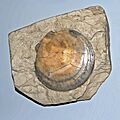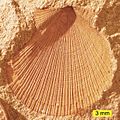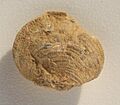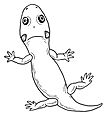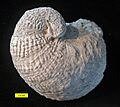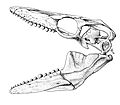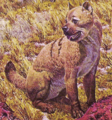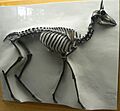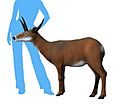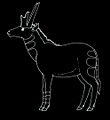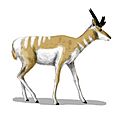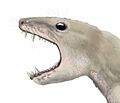List of the prehistoric life of Texas facts for kids
This article explores the amazing ancient creatures and plants that once lived in Texas. Scientists have found many fossils here, showing us what life was like millions of years ago. From tiny sea creatures to giant dinosaurs and early mammals, Texas has a rich history of prehistoric life!
Contents
Ancient Life in Texas: A Journey Through Time
Texas has a long and fascinating history of life, stretching back hundreds of millions of years. Scientists study fossils found in the state to learn about the different plants and animals that lived here long before humans existed. These fossils help us understand how life on Earth has changed over vast periods of time.
Paleozoic Era: Early Life Forms (541 to 252 Million Years Ago)
During the Paleozoic Era, Texas was often covered by shallow seas. This means many of the fossils from this time are of marine (ocean) creatures. However, as time went on, land animals and plants also started to appear.
One of the earliest periods, the Precambrian (before 541 million years ago), doesn't have many known fossils in Texas. But as we move into the Paleozoic, the fossil record becomes much richer.
Sea Creatures and Early Land Animals
Many ancient sea animals, like those with shells and early fish, lived in the waters covering Texas. Later, during the Permian Period, the land became home to some of the first large animals.
- Acheloma: This was an early amphibian, a bit like a giant salamander, that lived in swampy areas.
- Dimetrodon: One of the most famous prehistoric animals from Texas, Dimetrodon was a reptile-like creature with a large sail on its back. This sail might have helped it control its body temperature.
- Edaphosaurus: Another sail-backed animal, Edaphosaurus was a plant-eater, unlike the meat-eating Dimetrodon.
- Eryops: A large, crocodile-like amphibian that spent a lot of its time in water.
- Diplocaulus: This amphibian had a very unusual boomerang-shaped head!
- Seymouria: An important animal because it had features of both amphibians and reptiles, showing how life was evolving.
- Helicoprion: A strange shark relative with a spiral-shaped "tooth whorl" in its jaw.
- Cacops: A small, heavily armored amphibian.
- Archeria: An early amphibian that lived in the water.
- Ophiacodon: A large, early reptile-like animal that was a meat-eater.
- Cotylorhynchus: A very large, barrel-bodied reptile-like animal that ate plants.
- Captorhinus: A small, lizard-like reptile.
- Pantylus: A small, stout reptile.
- Platyhystrix: An amphibian with a tall, spiny sail on its back, similar to Dimetrodon.
- Psaronius: A type of ancient tree fern that grew very tall, forming forests.
- Pecopteris: A common fern-like plant.
- Calamites: A giant relative of modern horsetails.
Mesozoic Era: The Age of Dinosaurs (252 to 66 Million Years Ago)
The Mesozoic Era is often called the "Age of Dinosaurs," and Texas was certainly home to many of these magnificent creatures. This era is divided into three periods: the Triassic, Jurassic, and Cretaceous.
Triassic Period: The Dawn of Dinosaurs
In the Triassic, early dinosaurs and their relatives began to appear.
- Postosuchus: A large, crocodile-like predator that was one of the top hunters before dinosaurs became dominant.
- Shuvosaurus: A strange reptile that looked a bit like a dinosaur, but was actually a crocodile relative. It had a beak instead of teeth.
- Dromomeron: An early relative of dinosaurs.
- Metoposaurus: A large, flat-headed amphibian that lived in rivers and lakes.
- Arganodus: An ancient lungfish.
Cretaceous Period: Dinosaurs Roam Texas
The Cretaceous Period saw the peak of dinosaur diversity. Many famous dinosaurs and other reptiles lived in Texas during this time.
- Acrocanthosaurus: A huge, meat-eating dinosaur, similar to T. rex but with a distinctive ridge along its spine.
- Alamosaurus: A massive, long-necked, plant-eating dinosaur (a sauropod) that was one of the last dinosaurs to live in North America.
- Sauroposeidon: Another incredibly tall, long-necked dinosaur, possibly the tallest animal to ever live. Its footprints, known as Brontopodus, are found in Texas.
- Tenontosaurus: A plant-eating dinosaur related to Iguanodon.
- Protohadros: A duck-billed dinosaur.
- Texacephale: A small, dome-headed dinosaur.
- Texasetes: A type of armored dinosaur (an ankylosaur).
- Deinosuchus: A giant crocodile relative, much larger than modern crocodiles, that preyed on dinosaurs.
- Quetzalcoatlus: An enormous flying reptile (a pterosaur) with a wingspan as large as a small airplane. It was one of the largest animals to ever fly.
- Mosasaurus: A giant marine reptile, similar to a lizard but adapted for ocean life. It was a fierce predator in the ancient seas.
- Brachauchenius: Another large marine reptile, a type of plesiosaur with a short neck.
- Libonectes: A long-necked plesiosaur that swam in the ancient Texas seas.
- Triceratops: While not as common as in other states, some fossils of this famous horned dinosaur have been found in Texas.
- Tyrannosaurus: The mighty T. rex also lived in Texas, though its fossils are rare here.
- Enchodus: A bony fish with long, saber-like teeth, sometimes called the "saber-toothed herring."
- Baculites: A type of ammonite (a shelled, squid-like creature) with a straight shell, unlike most ammonites which have coiled shells.
- Exogyra: A common type of fossil oyster with a distinctive twisted shell.
Cenozoic Era: The Rise of Mammals (66 Million Years Ago to Today)
After the dinosaurs disappeared, mammals began to dominate the Earth. The Cenozoic Era in Texas saw a wide variety of mammals, from tiny rodents to giant elephants and saber-toothed cats.
Early Mammals and Giant Beasts
- Hyracotherium: One of the earliest ancestors of horses, about the size of a small dog.
- Uintatherium: A large, rhino-like mammal with bony knobs and horns on its head.
- Titanoides: A large, heavy-bodied mammal with strong claws.
- Allognathosuchus: An ancient alligator relative.
- Hyaenodon: A large, powerful meat-eating mammal, similar to a hyena but not closely related.
- Metamynodon: A swamp rhinoceros, similar to a hippo.
- Daphoenodon: A "bear-dog," an ancient type of carnivore that looked like a mix between a bear and a dog.
- Epicyon: A large, bone-crushing dog.
- Borophagus: Another type of bone-crushing dog.
- Teleoceras: A short-legged, barrel-bodied rhinoceros that lived in herds.
- Aepycamelus: A "giraffe-camel" with a very long neck.
- Synthetoceras: A deer-like animal with unusual Y-shaped horns on its nose.
- Cranioceras: A relative of modern deer with horns on its skull.
- Nannippus: A small, three-toed horse.
- Pliohippus: A single-toed horse, very similar to modern horses.
- Mammuthus columbi: The Columbian mammoth, a giant elephant relative that roamed Texas during the Ice Age.
- Mammut americanum: The American mastodon, another large elephant relative, known for its cone-shaped teeth.
- Cuvieronius: A type of gomphothere, an elephant relative with four tusks.
- Stegomastodon: Another gomphothere, with shorter, more curved tusks.
- Smilodon fatalis: The famous saber-toothed cat, a powerful predator with long, sharp canine teeth.
- Homotherium: The scimitar cat, another saber-toothed cat with shorter, broader teeth.
- Arctodus simus: The short-faced bear, a very large and powerful bear.
- Glyptotherium texanum: A giant armadillo-like animal covered in bony plates.
- Paramylodon harlani: A large ground sloth.
- Nothrotheriops: Another type of ground sloth.
- Camelops: The North American camel, a large camel that lived during the Ice Age.
- Bison latifrons: The giant long-horned bison, much larger than today's bison.
- Canis dirus: The dire wolf, a large wolf that hunted big prey.
- Ceratogaulus: A horned gopher, a rodent with two horns on its snout.
- Gopherus polyphemus: A type of tortoise.
Images for kids
-
Life restoration of the Permian synapsid (mammal precursor) Edaphosaurus
-
Life restoration of the Carboniferous-Permian amphibian Eryops
-
Life restoration of the Permian Chimaera relative Helicoprion
-
Fossilized skeleton of the Permian primitive four-limbed animal Seymouria
-
Life restoration of the Early Cretaceous theropod dinosaur Acrocanthosaurus
-
Mounted fossilized skeleton of the Late Cretaceous Alligator relative Deinosuchus
-
Restoration of the Late Cretaceous toothed bird Ichthyornis
-
Life restoration of the Late Cretaceous plesiosaur Libonectes with an anachronistic scuba diver to scale
-
Life restoration of two of the Late Cretaceous Mosasaurus
-
Fossilized shell of the Late Cretaceous ammonoid cephalopod Parapuzosia with a human indicating its size
-
Mounted fossilized skeleton of the Late Cretaceous pterosaur Quetzalcoatlus
-
Diagram illustrating the Early Cretaceous long-necked dinosaur Sauroposeidon with anachronistic humans to scale
-
Life restoration of the Late Cretaceous ostrich dinosaur Struthiomimus
-
Life restoration of the Early Cretaceous Iguanodon relative Tenontosaurus
-
Mounted fossilized skeleton of the Late Cretaceous horned dinosaur Triceratops
-
Fossilized skeleton of the Late Cretaceous tyrannosaur Tyrannosaurus
-
Restoration of an Arctodus, or short-faced bear, with a human to scale
-
Restoration of two of the Miocene-Pliocene bone-crushing dog genus Borophagus preying on a camel. Jay Matternes (1964).
-
Mounted fossilized skeleton of the Pliocene-Holocene camel Camelops
-
A living Coluber constrictor, or eastern racer
-
Fossilized skeleton of the Pliocene-Pleistocene horse Equus simplicidens, also known as the Hagerman horse or American zebra
-
A living Ficus, or fig tree
-
A living Heterodon nasicus, or Western hognose snake
-
Restoration of Pliocene-Pleistocene Homotherium, or scimitar cat
-
A living Lampropeltis getula, or eastern kingsnake
-
Life restoration of a herd of Mammuthus columbi, or Columbian mammoths. The extent of the fur depicted is hypothetical. Charles R. Knight (1909).
-
Restoration of the Pliocene-Holocene ground sloth Megatherium. Robert Bruce Horsfall (1913).
-
Restoration of the Eocene-Miocene swamp rhinoceros Metamynodon. Charles R. Knight (1896).
-
Fossilized skeleton of the Pliocene-Pleistocene ground sloth Paramylodon
-
Restoration of a herd of alarmed Miocene-Pleistocene peccaries of the genus Platygonus. Charles R. Knight (1922).
-
A living Rana catesbeiana (sometimes Lithobates catesbeianus), or American bullfrog
-
A living Xerospermophilus spilosoma, or spotted ground squirrel
-
Life restoration of the Pleistocene-Holocene saber-tooth cat Smilodon
-
A living Terrapene carolina, or common box turtle


